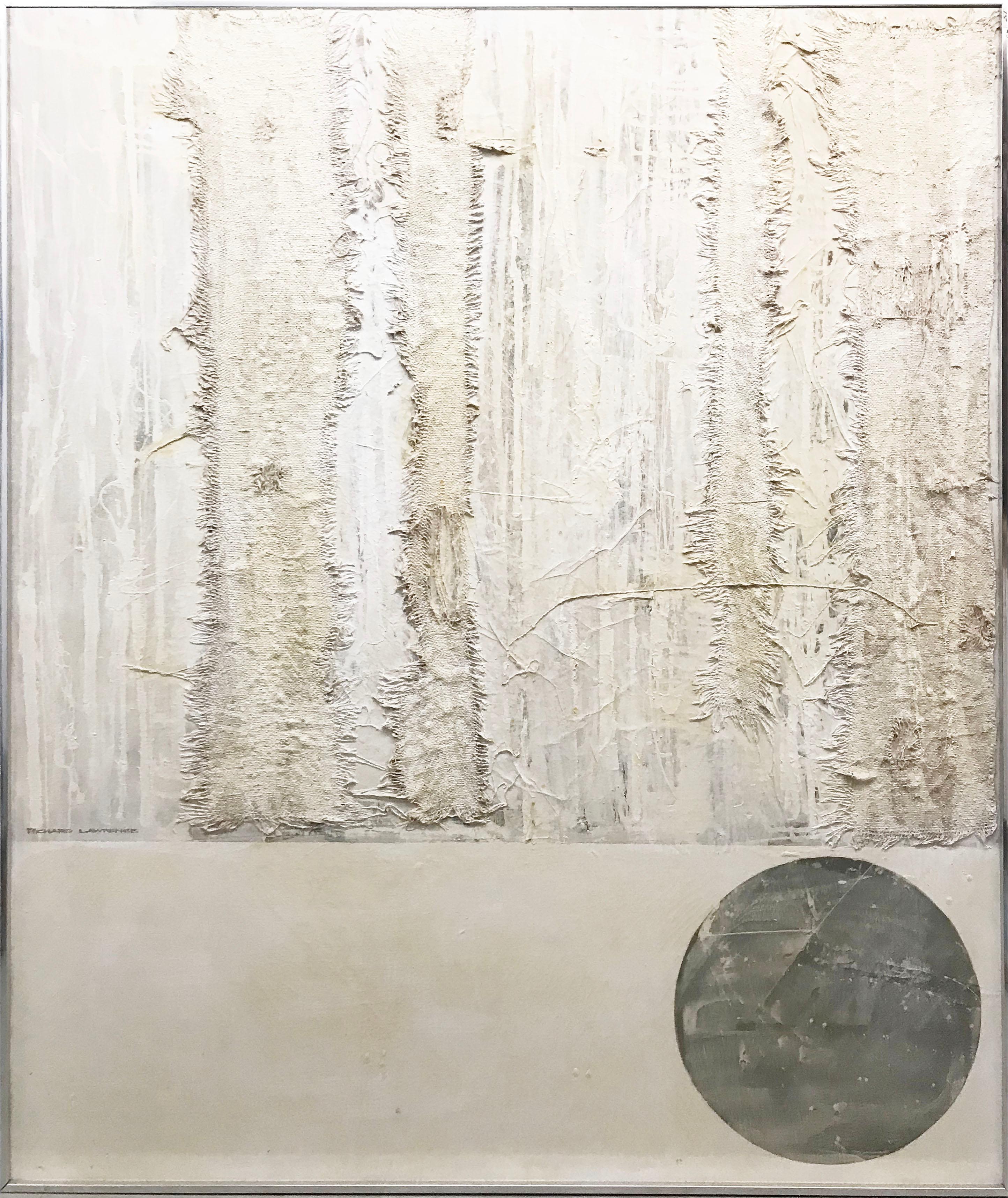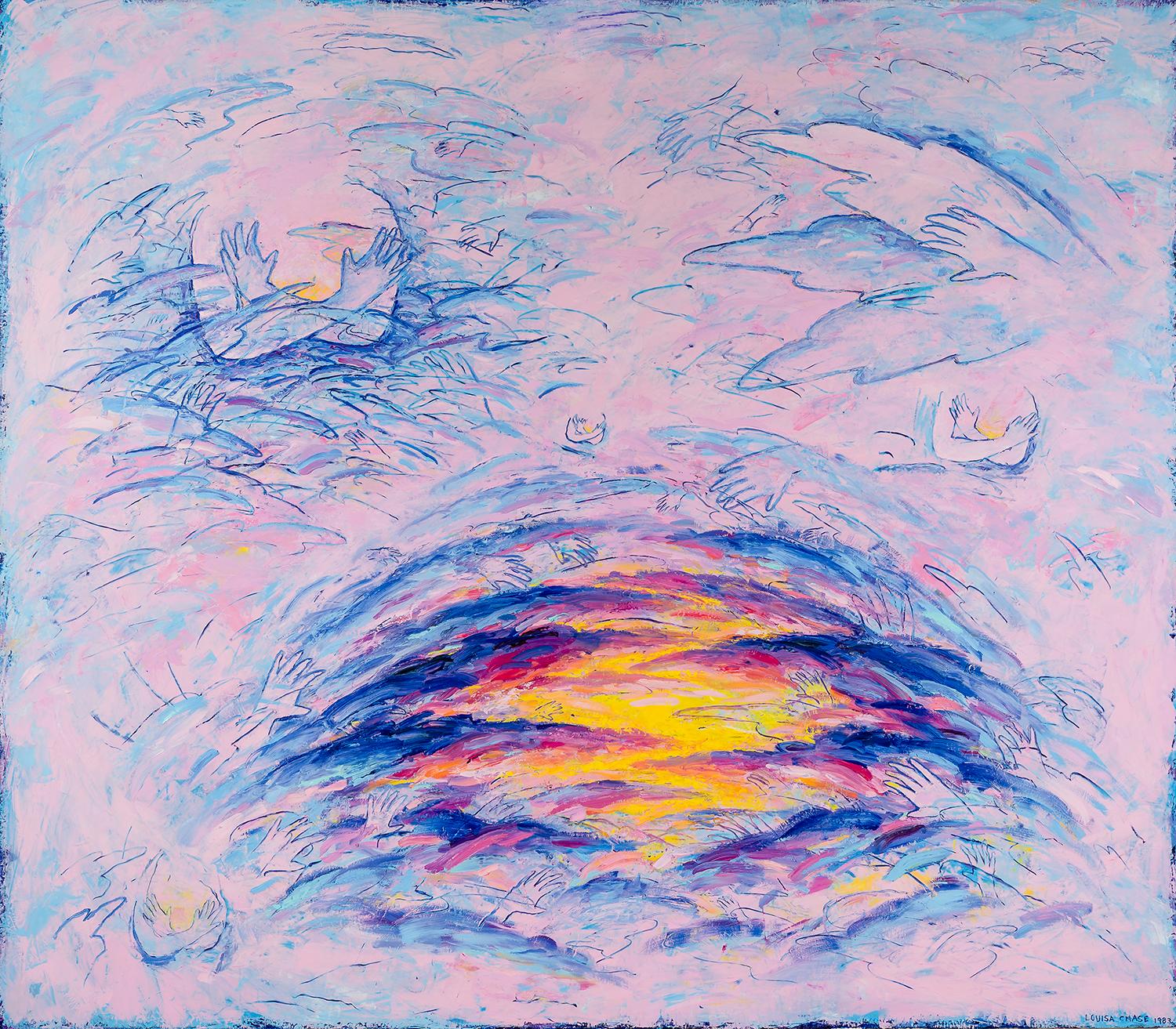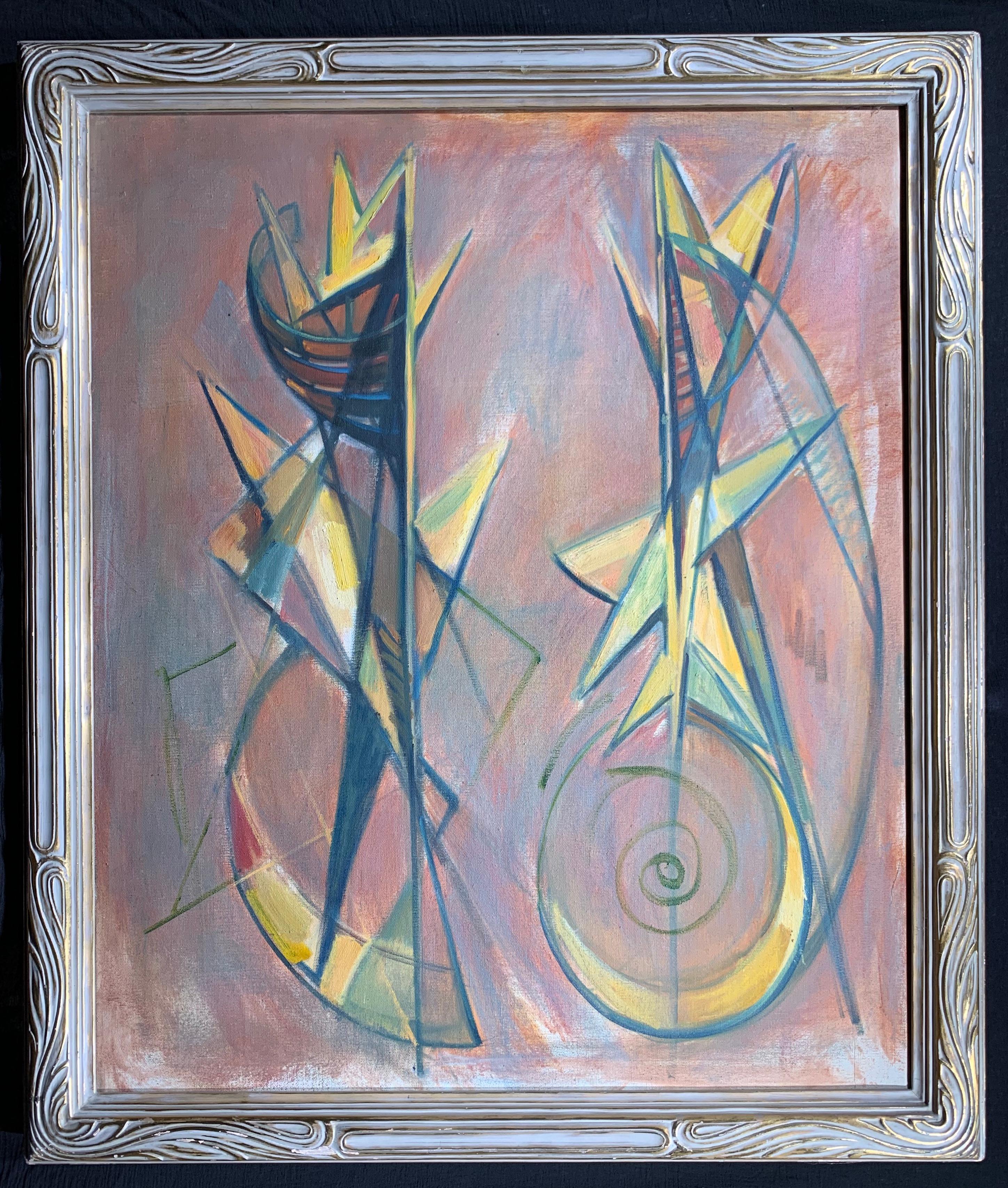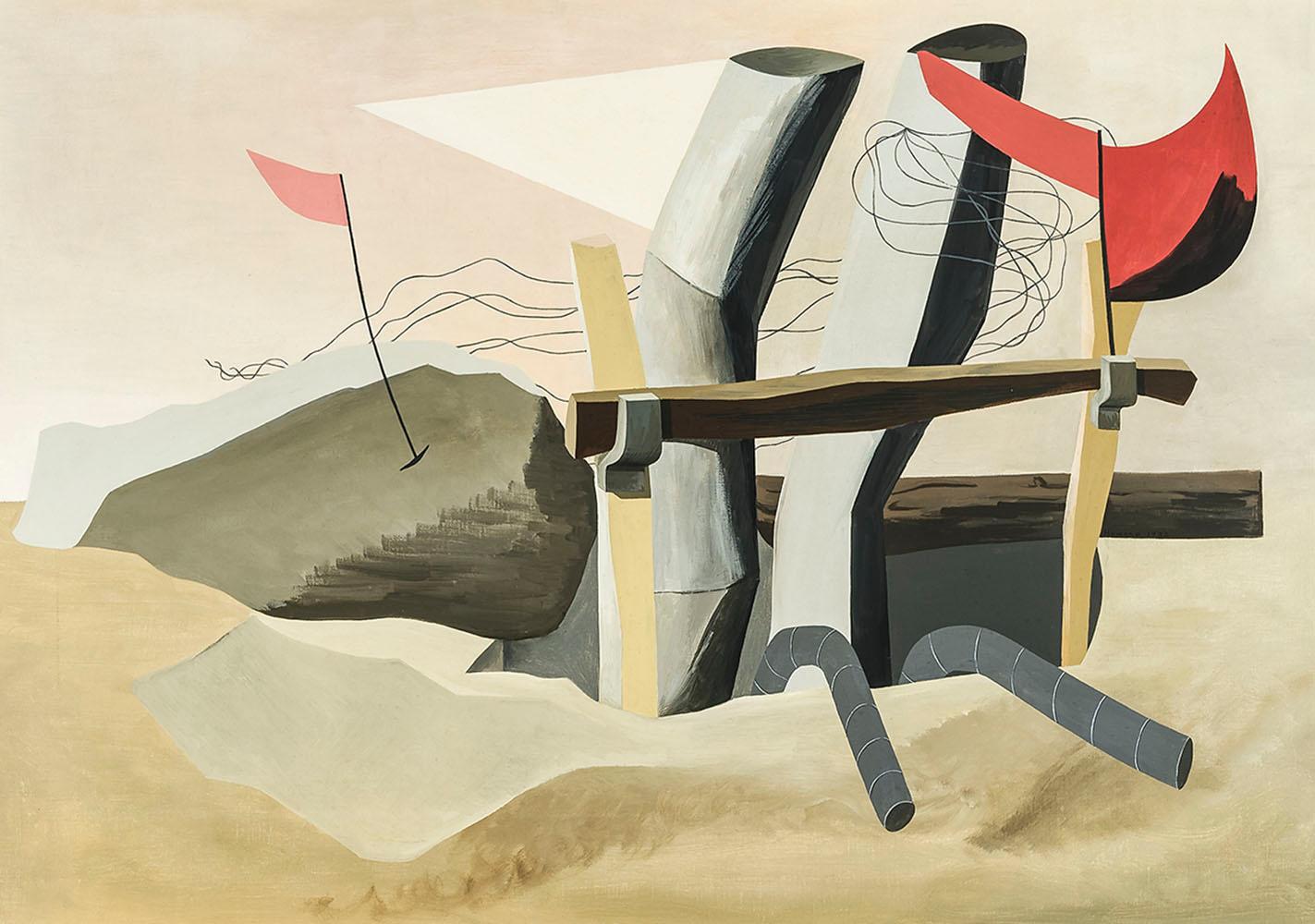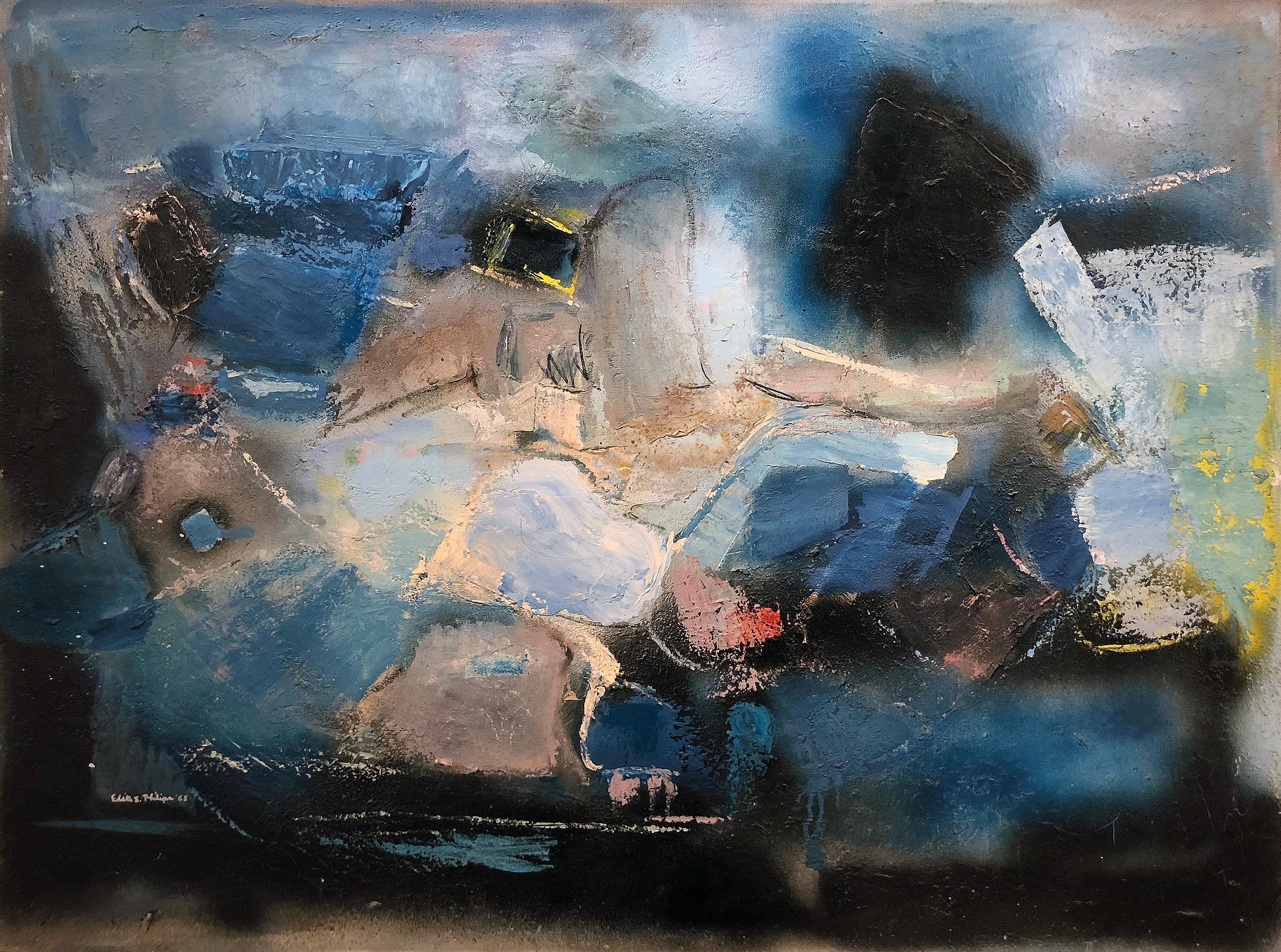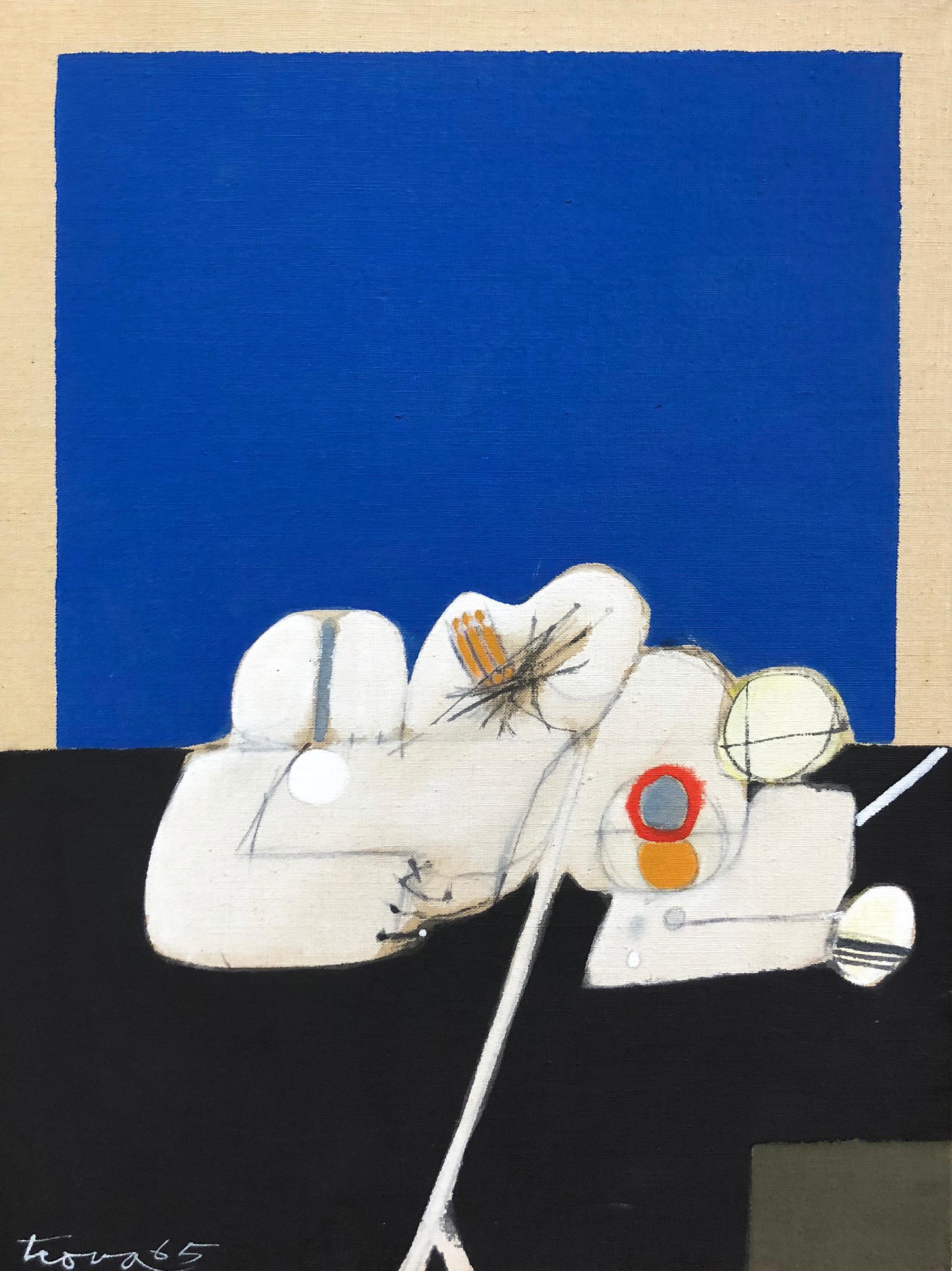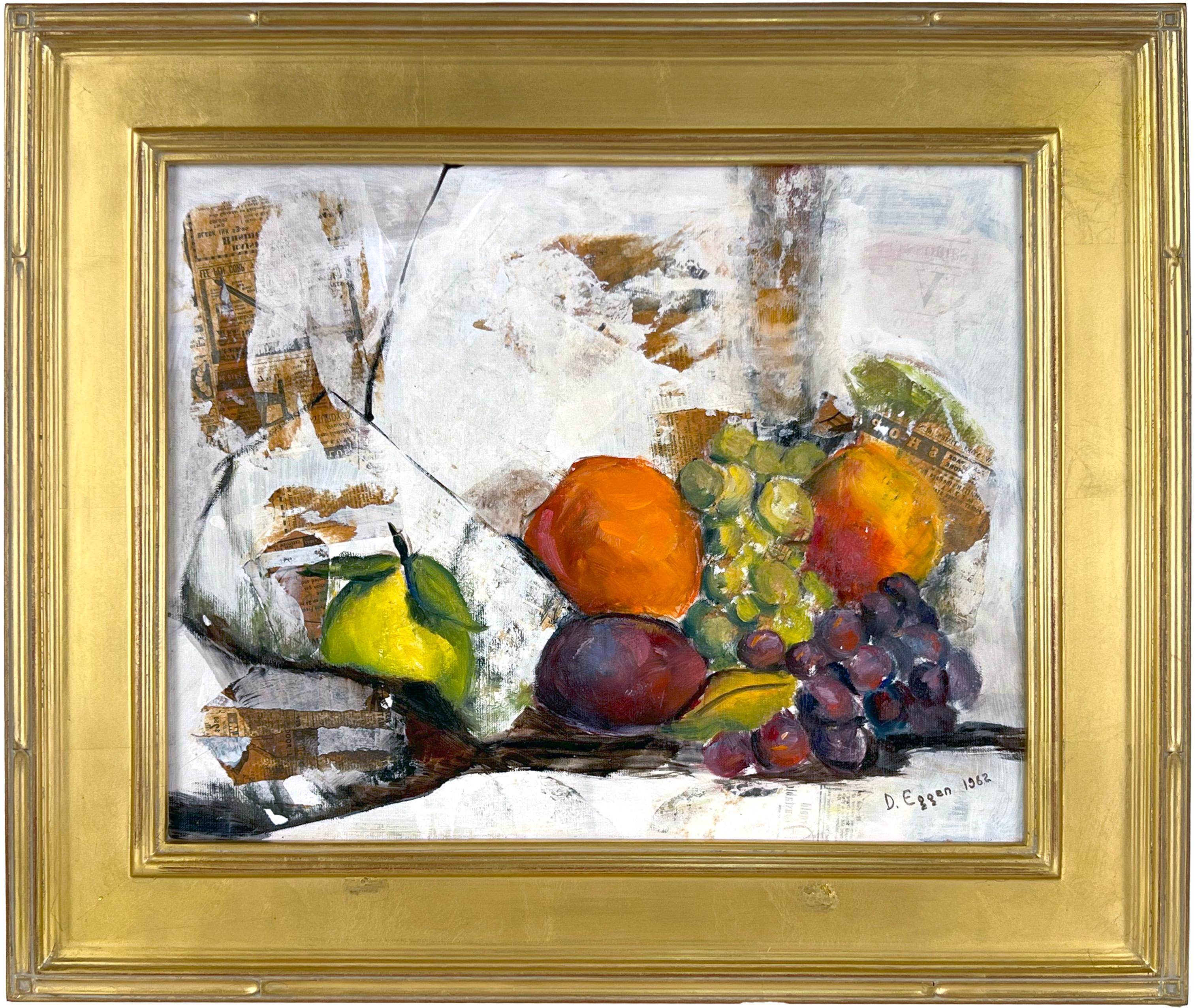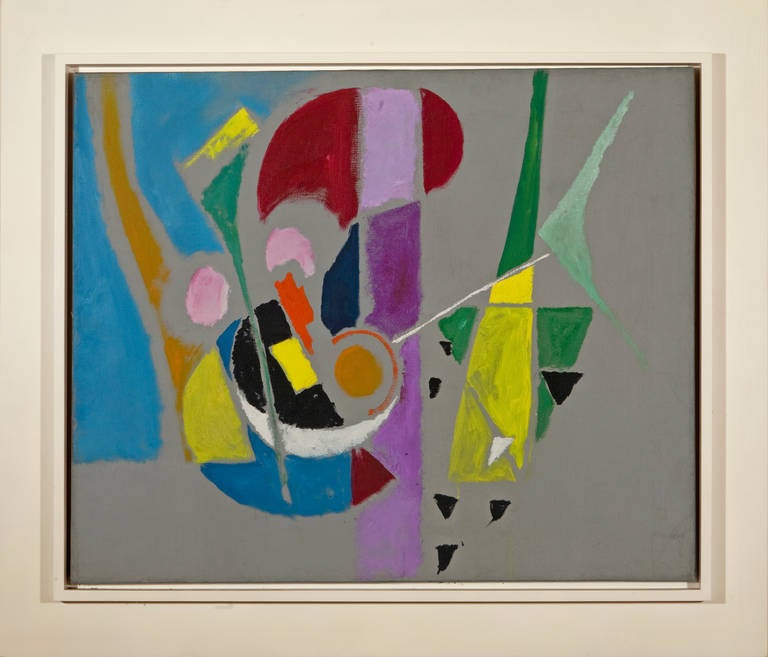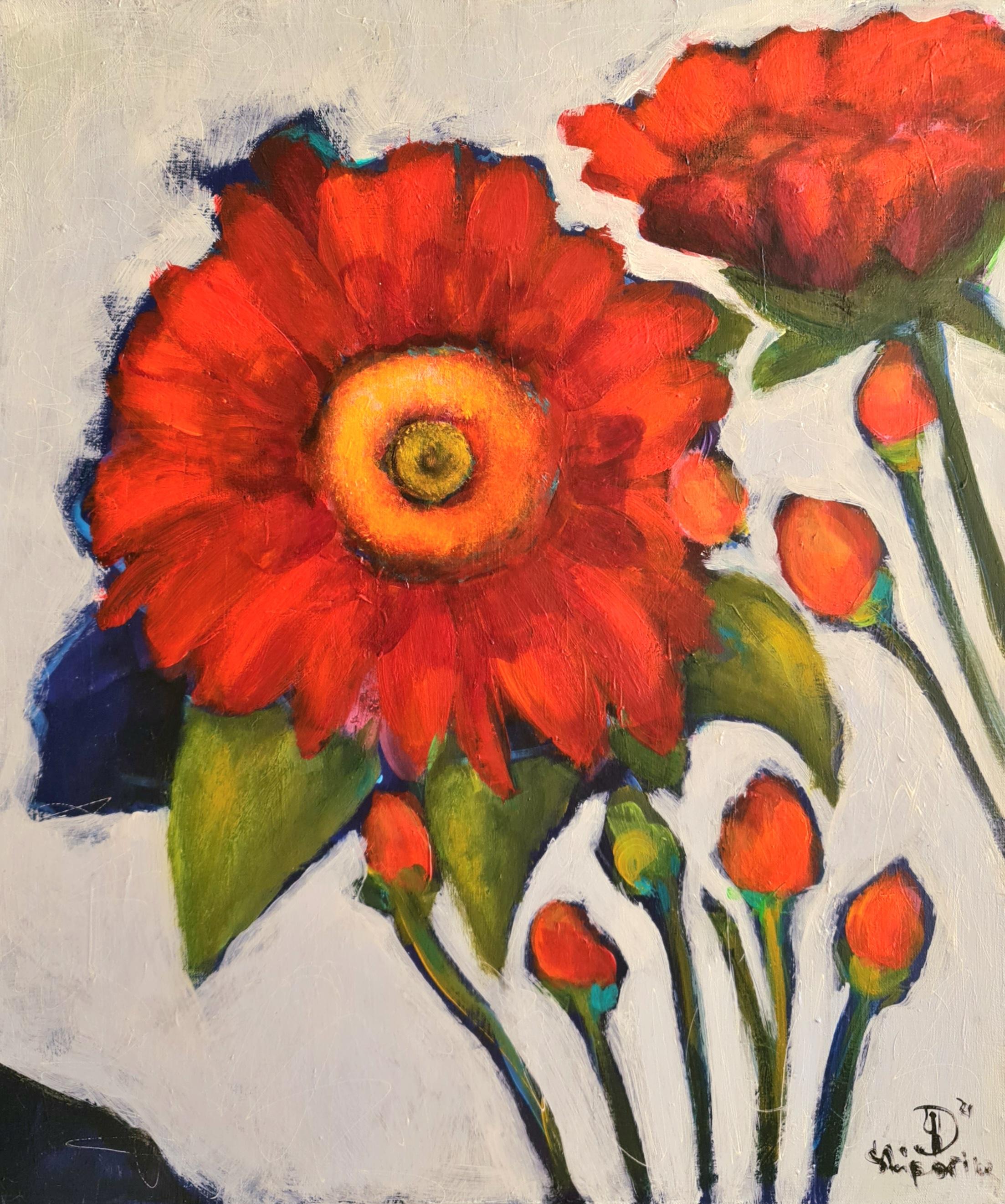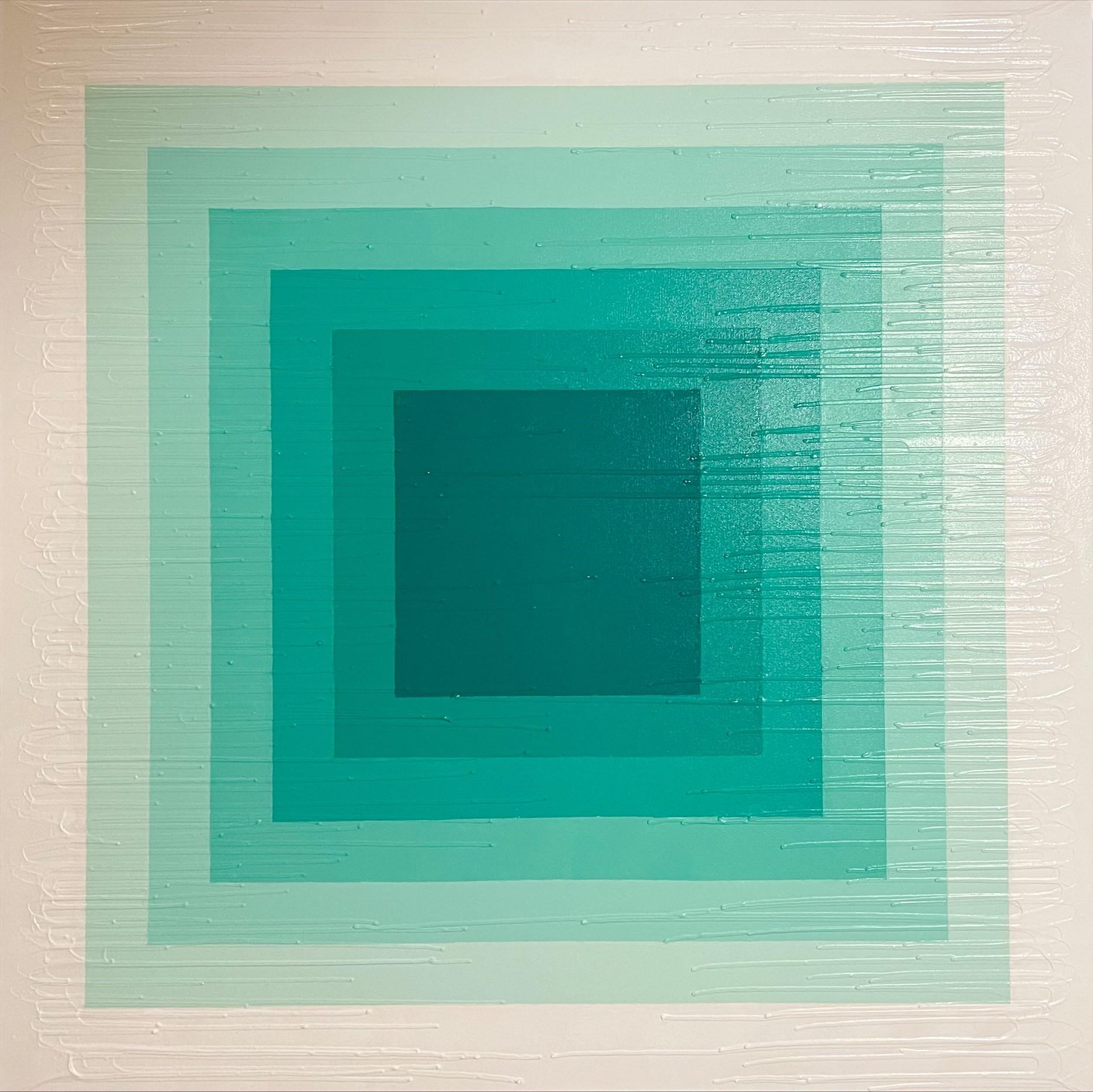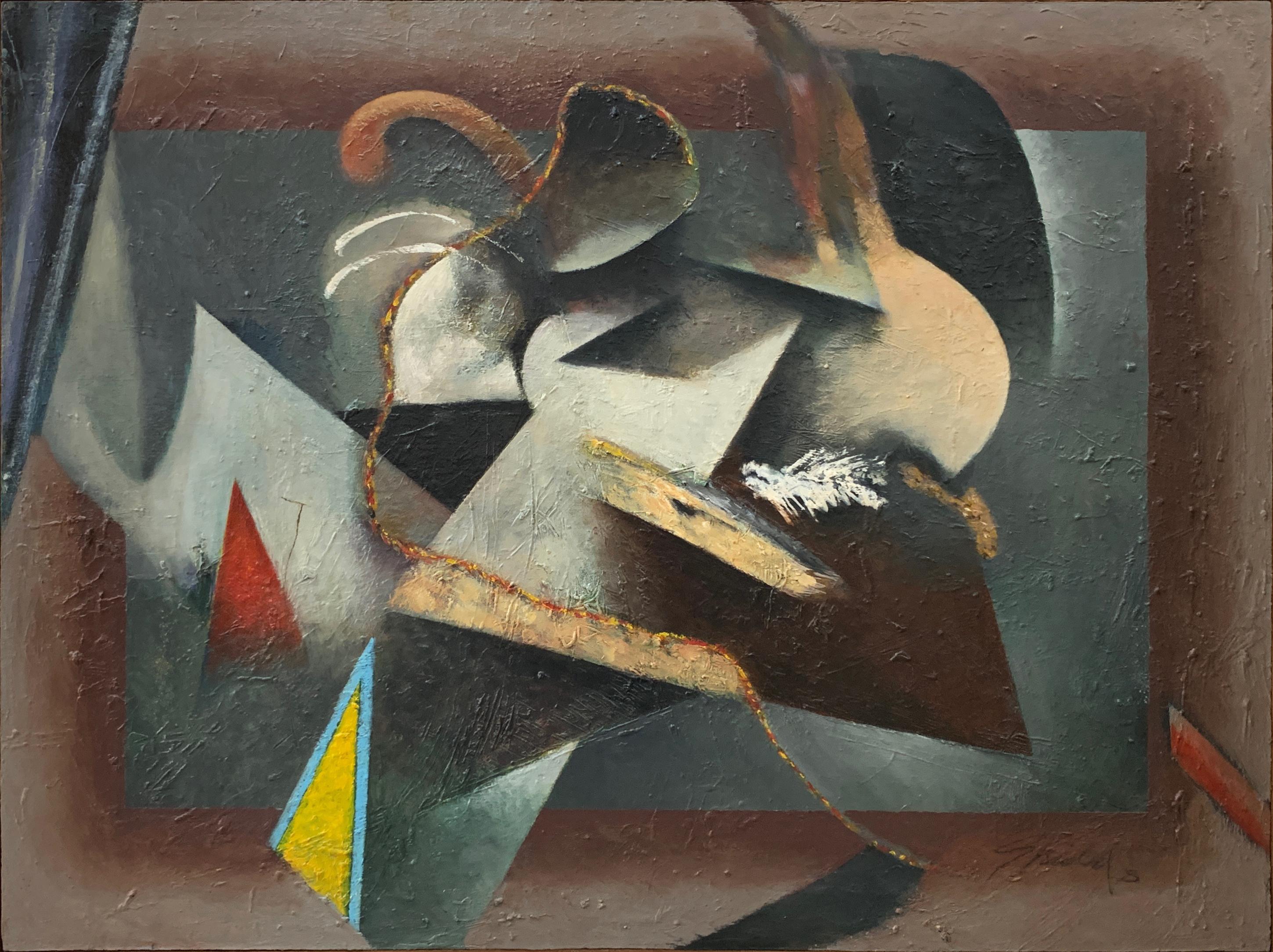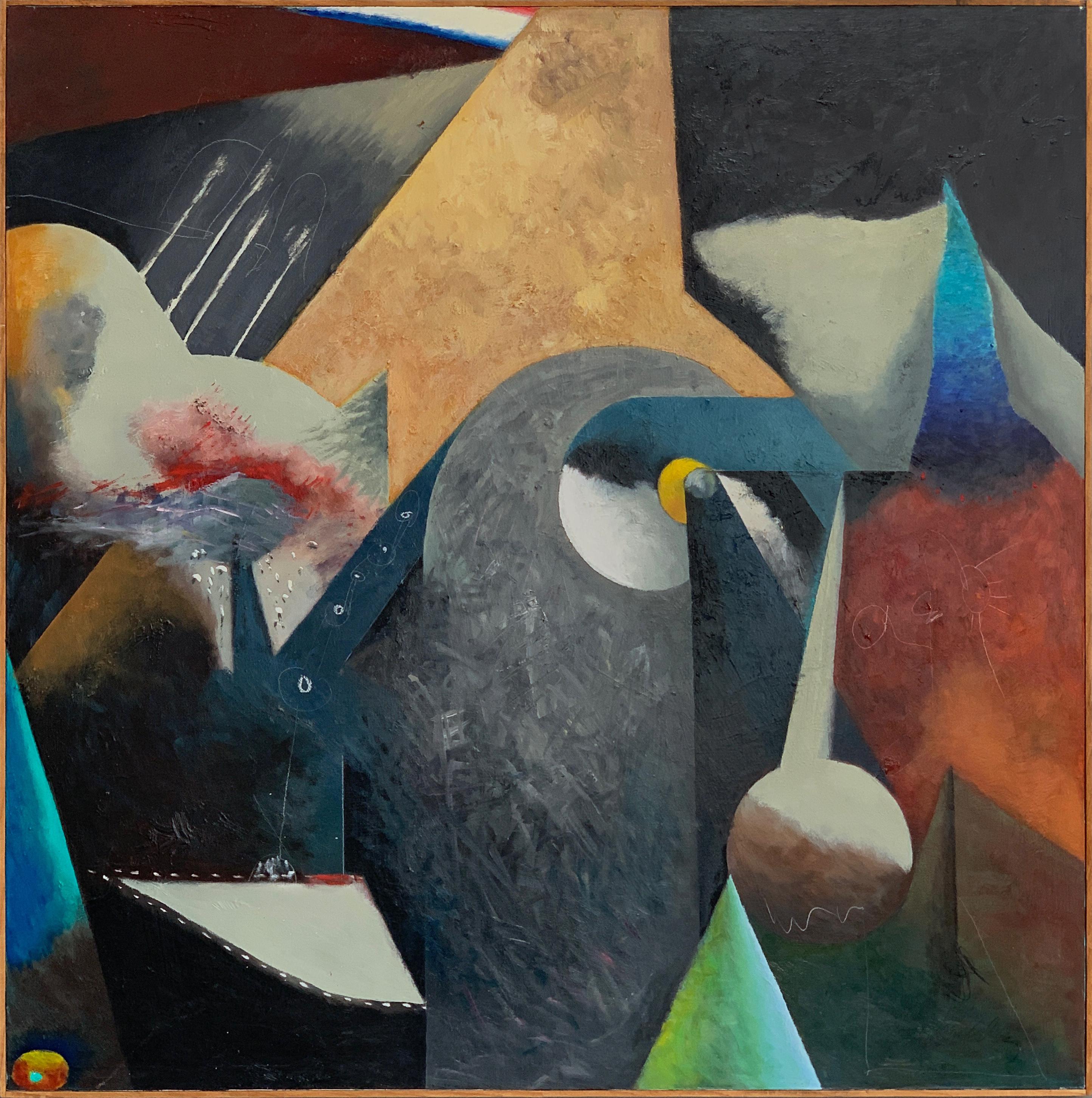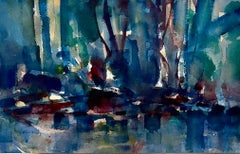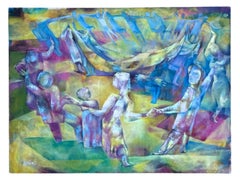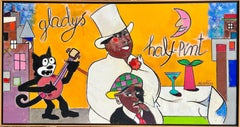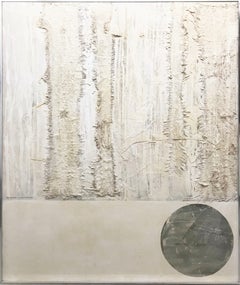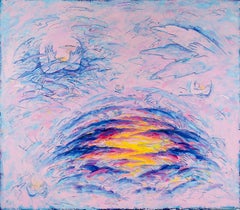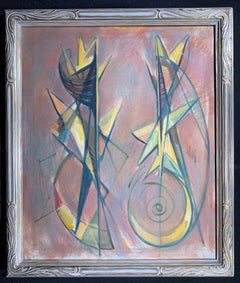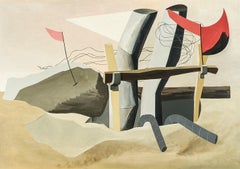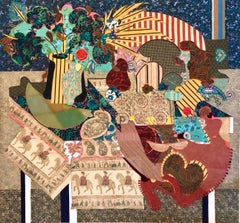
Large Mixed Media Mod Fabric Collage Textile Painting Modernist Art Wall Hanging
View Similar Items
Want more images or videos?
Request additional images or videos from the seller
1 of 18
John UdvardyLarge Mixed Media Mod Fabric Collage Textile Painting Modernist Art Wall Hanging1963
1963
About the Item
- Creator:John Udvardy (1936)
- Creation Year:1963
- Dimensions:Height: 53 in (134.62 cm)Width: 57 in (144.78 cm)
- Medium:
- Movement & Style:
- Period:
- Condition:minor wear. frame has wear.
- Gallery Location:Surfside, FL
- Reference Number:1stDibs: LU3827010952
About the Seller
4.9
Platinum Seller
Premium sellers with a 4.7+ rating and 24-hour response times
Established in 1995
1stDibs seller since 2014
1,751 sales on 1stDibs
Typical response time: 2 hours
Authenticity Guarantee
In the unlikely event there’s an issue with an item’s authenticity, contact us within 1 year for a full refund. DetailsMoney-Back Guarantee
If your item is not as described, is damaged in transit, or does not arrive, contact us within 7 days for a full refund. Details24-Hour Cancellation
You have a 24-hour grace period in which to reconsider your purchase, with no questions asked.Vetted Professional Sellers
Our world-class sellers must adhere to strict standards for service and quality, maintaining the integrity of our listings.Price-Match Guarantee
If you find that a seller listed the same item for a lower price elsewhere, we’ll match it.Trusted Global Delivery
Our best-in-class carrier network provides specialized shipping options worldwide, including custom delivery.More From This Seller
View AllModernist Abstract Expressionist Watercolor Painting Bauhaus Weimar Pawel Kontny
By Pawel Kontny
Located in Surfside, FL
Abstract watercolor composition bearing the influence of the earlier color-block compositions of Paul Klee.
Pawel August Kontny, (Polish-German-American artist) He was born in Laurahuette, Poland, in 1923, the son of a wealthy pastry shop owner. In 1939 he began studying architecture in Breslau where he was introduced to the European masters and to the work of some of the German Expressionists, soon afterward banned as "degenerate artists" and removed from museums throughout Germany by the Nazi regime. His studies were interrupted by World War II. Drafted into the German army, traveling in many countries as a soldier, he sketched various landscapes but in 1945, he was captured and held as a prisoner of war in Italy. After the war, he studied at the Union of Nuremberg Architects to help design buildings to replace ones destroyed in the war. He recorded his impressions of the local population and the landscapes through his watercolors and drawings. Pawel Kontny thereafter moved to Nuremberg, Germany, becoming a member of the Union of Nuremberg Architects and helping to rebuild the city's historic center. He soon decided to concentrate on his professional art career. He married Irmgard Laurer, a dancer with the Nuremberg Opera. Pavel Kontny 's career as an artist was launched with his participation in an all German exhibition, held at the Dusseldorf Museum in 1952. He held one-man shows in Germany, Switzerland and the United States. During his trip to the United States in 1960, Kontny became instantly enamored with Colorado, and decided to relocate to Cherry Hills with his wife and two children. He quickly established himself in the local art community, being affiliated for a time with Denver Art Galleries and Saks Galleries. His subject matter became the Southwest. During this time he received the Prestigious Gold Medal of the Art Academy of Rome. His extensive travel provided material for the paintings he did using his hallmark marble dust technique. he also worked equally in pastel, watercolor, charcoal and pencil-and-ink. in a style which merged abstraction and realist styles, influenced by Abstract Expressionist painting and South Western American landscapes. In the early 1960s he was one of only a few European-born professional artists in the state, a select group that included Herbert Bayer (1900-1985), a member of the prewar Bauhaus in Weimar and Dessau, Germany, and Roland Detre (1903-2001), a Hungarian modernist painter. As a Denver, Colorado resident, Pavel Kontny exhibited at galleries and museums throughout the United States, Germany and Japan. There, he was inspired by frequent trips to Native American pueblos in the Southwest, as well as by the study of the Plains Indians of Montana and Wyoming. Over the years Kontny had a number of students and generously helped young artist by hosting exhibitions at his Cherry Hills home. For many years he generously donated his paintings to support charitable causes in Denver. Influences during his European years included German pastelist C.O. Muller, German Informel painter Karl Dahmen and Swiss artist, Hans Erni. In the early 1950s his painting style showed the influence of the Die Brücke (The Bridge), a group of German expressionist artists formed in Dresden in 1905 who had a major impact on the evolution of modern art in the twentieth century in Germany. By the middle of the decade his style incorporated more referential abstraction and total abstraction, resulting in part from his study of Hans Hartung, a German artist based in Paris who exhibited his gestural abstract work in Germany. The American moon landing in 1969 inspired Paul Kontny...
Category
20th Century American Modern Landscape Paintings
Materials
Canvas, Oil
Joseph Wolins WPA Artist Dancing, Torah Modernist Judaica Cubist Oil Painting
By Joseph Wolins
Located in Surfside, FL
Joseph Wolins 1915-1999
Subject: Jewish, Dancing with the Torah (New Torah, Simchat Torah)
Hand signed oil painting
In this painting, Joseph Wolins uses vibrant and complimentary co...
Category
20th Century American Modern Figurative Paintings
Materials
Canvas, Oil
Large Archie Rand Abstract Expressionist Cartoon Oil Painting Dusseldorf
By Archie Rand
Located in Surfside, FL
"Dusseldorf, Germany" 1993, oil on canvas, hand signed and dated lower left,
Canvas (unframed):18 X 48. framed: 19.5 X 49.5
Provenance: directly from the artist. Exhibited at Phyllis Kind Gallery in NYC in 1987.
Archie Rand (American, born 1949) is an artist from Brooklyn, New York.
Rand's work as a painter and muralist is held in the collections of the San Francisco Museum of Modern Art, the Art Institute of Chicago, the Victoria and Albert Museum in London, the Bibliothèque Nationale de France in Paris, and the Tel Aviv Museum of Art.
His graphic works and books are held by the Metropolitan Museum Of Art, the Museum of Modern Art, the Whitney Museum of American Art, the Art Institute Of Chicago, The Brooklyn Museum, the Baltimore Museum of Art, the Smithsonian Institution, and The New York Public Library; and are owned by Harvard, Yale, Columbia, Brown, and Johns Hopkins universities.
Born in Brooklyn, Rand received a Bachelor of Fine Arts in cinegraphics from the Pratt Institute, having studied previously at the Art Students League of New York.
His first exhibition was in 1966, at the Tibor de Nagy Gallery in New York. He has since had over 100 solo exhibitions, and his work has been included in over 200 group exhibitions.
He is currently Presidential Professor of Art at Brooklyn College which granted him the Award for Excellence in Creative Achievement in 2016. Before joining Brooklyn College, Rand was the chair of the Department of Visual Arts at Columbia University.
The Italian Academy For Advanced Studies in America at Columbia University presented him with The Siena Prize in 1995. He was awarded a Guggenheim Foundation Foundation Fellowship in 1999 and was made a Laureate of the National Foundation for Jewish Culture, which awarded him the Achievement Medal for Contributions in the Visual Arts. In 2002 he received the Presidential Award for Excellence in Teaching from Columbia University.
In 2002 he became the artistic advisor to film director Ang Lee for his production of The Hulk, and was asked by Milestone Films to provide a commentary track for the DVD release of Henri-Georges Clouzot’s classic 1955 film The Mystery of Picasso.
Archie Rand’s earliest major works are “The Letter Paintings” (or “The Jazz Paintings”) (1968–71), a radically positioned series of technically inventive, mural-sized canvases. The Letter Paintings, by incorporating the names of mainly male and female African-American musicians, undermined prevailing aesthetic categories by conflating many contemporary movements including Conceptual Art, Color Field, Pattern and Decoration, diary entry and social commentary.
In 1974 Rand received a commission from Congregation B’nai Yosef in Brooklyn. Rand was asked to paint thematic murals on the complete 16,000-square-foot (1,500 m2) interior surfaces of the synagogue. The work took three years, and completing this commission made Rand the author of the only narratively painted synagogue in the world and the only one we know of since the 2nd Century Dura-Europos. The religious legal controversy raised by placing wall paintings in a traditionally iconoclastic space was resolved by the verdict of Rabbi Moshe Feinstein, then considered to be the world’s leading Talmudic scholar, who declared the paintings to be in conformity with the law. His subsequent turn to figuration may have been influenced by his friendship with Philip Guston, whose own work was transformed in the late 1960s. Like Guston, Rand "chafed at the limitations of purely abstract forms."
A near-cult figure who started out as a child prodigy and whose admirers range from John Ashbery to Julian Schnabel. Rand’s paintings display a vast and savvy menu of inventive and finely executed approaches. He has completed many series after the works of Paul Celan, Moyshe-Leyb Halpern, Eugenio Montale, Yehuda Amichai, Rainer Maria Rilke, Samuel Beckett/Paul Eluard and Jack Spicer. Working often with poets, he has produced books and continues to engage in publishing collaborative projects. He maintained a correspondence with the American British Jewish painter R.B. Kitaj.
In 2008, on a warehouse wall, Rand mounted the painting, “The 613”, which at 1700 square feet (17’ x 100’) is nearly twice the size of James Rosenquist’s F-111. It is one of the largest freestanding paintings ever made. Reminiscent of “The Segments” paintings it is intimidatingly enormous. Paradoxically, despite the raucous cartoony bytes that shoot colorful flashes from the manic surface, “The 613” glows warmly. Its overall effect is strangely calming and majestic.
In an article on a 2011 exhibition of Rand's "Had Gadya" series, David Kaufmann wrote:
Rand displayed his work in 15 solo exhibitions between 2008 and 2017, many of them showcasing paintings done after Scripture, or his workings with poets: Including “Had Gadya, 2005”, Borowsky Gallery, Philadelphia, PA (2011); “Gods Change, Prayers Are Here To Stay (after Yehuda Amichai), 2000", Katz Gallery, Atlanta, GA (2014); “Psalm 68, 1994”, Derfner Museum, Riverdale, NY (2014); “The Chapter Paintings”, Tribeca Gallery, NY (2015); “Men Who Turn Back (after Eugenio Montale), 1995", SRO Gallery, Brooklyn, NY (2016); “Sixty Paintings From the Bible” & “The Book of Judith, 2012”, Cleveland State University Galleries, Cleveland, OH (2016) & The American Jewish Museum, Pittsburgh, PA (2017); “Archie Rand: Early Works With Poetry: Jack Spicer, 1991 and Samuel Beckett/Paul Eluard, 1993”, St. Francis College, Brooklyn, NY (2017).
"The 613"
In 2015 Blue Rider/Penguin/Random House published The 613, allotting one color plate per page for each of the 614 units in the painting. The Wall Street Journal labeled The 613 as “dynamic…remarkable…thrilling” The New York Times selected the book as “Editors' Choice” and praised it in two separate reviews calling it “wonderfully garish” and declaring that “nothing prepared the art world for 'The 613.'
Recent Activity
In 2016 Rand showed two bodies of work that were done in Italy, “La Certosa Di Pontignano, 1995” and “Mount Etna, 2005,” at The Interchurch Center Galleries, New York. From 2016 to 2017 he served as the Curator and Juror for the Governor of Wyoming’s Capitol Arts Exhibition at The Wyoming State Museum, Cheyenne, WY.
A 2017 exhibition, “Archie Rand: Early Works With Poetry”, featured two series of work from 1991 and 1993 after poems by Jack Spicer and Samuel Beckett/Paul Eluard.
This painting was exhibited in the Phyllis Kind Gallery in NY in 1987.
(Phyllis Kind was an American art dealer active in Chicago and New York. She promoted the work of the Chicago Imagists, The Monster Roster and The Hairy Who and outsider artists. Kind opened a gallery in Chicago in 1967. Called Pro Grafica Arte, the gallery dealt in master prints and drawings. In 1975, she opened a gallery on Spring Street in New York's SoHo district. She gave some of the artists in the movement their first solo shows: Jim Nutt and Gladys Nilsson...
Category
1980s American Modern Figurative Paintings
Materials
Canvas, Oil
Large Richard Merkin Painting Harlem Jazz Club, New Yorker Magazine Cover Artist
By Richard Merkin
Located in Surfside, FL
Richard Marshall Merkin (American, 1938-2009)
Gladys and Half-Pint
Hand signed 'Merkin' (center right),
Titled, inscribed, dated, and initialed 'GLADYS BENTLEY AND FRANKIE 'HALF-PINT' JAXON 1997/R.M.' verso.
Oil on canvas
37 1/2 x 72 in. (95.3 x 182.9 cm)
framed 39 1/4 x 74 x 2 in.
Gladys Alberta Bentley (August 12, 1907 – January 18, 1960) was an American blues singer, pianist, and entertainer during the Harlem Renaissance. Her career skyrocketed when she appeared at Harry Hansberry's Clam House, a well-known gay speakeasy in New York in the 1920s, as a black, lesbian, cross-dressing performer. She headlined in the early 1930s at Harlem's Ubangi Club, where she was backed up by a chorus line of drag queens. She dressed in men's clothes (including a signature tailcoat and top hat), played piano, and sang her own raunchy lyrics to popular tunes of the day in a deep, growling voice while flirting with women in the audience. On the decline of the Harlem speakeasies with the repeal of Prohibition, she relocated to southern California, where she was billed as "America's Greatest Sepia Piano Player" and the "Brown Bomber of Sophisticated Songs". She was frequently harassed for wearing men's clothing. She tried to continue her musical career but did not achieve as much success as she had had in the past. Bentley was openly lesbian early in her career, but during the McCarthy Era she started wearing dresses and married, claiming to have been "cured" by taking female hormones.
Frankie "Half-Pint" Jaxon, born Frank Devera Jackson was an African American vaudeville singer, stage designer and comedian, popular in the 1920s and 1930s. He was born in Montgomery, Alabama, orphaned, and raised in Kansas City, Missouri. His nickname of "Half Pint" referred to his 5'2" height. He started in show business around 1910 as a singer in Kansas City, before travelling extensively with medicine shows in Texas, and then touring the eastern seaboard. His feminine voice and outrageous manner, often as a female impersonator, established him as a crowd favorite. By 1917 he had begun working regularly in Atlantic City, New Jersey and in Chicago, often with such performers as Bessie Smith and Ethel Waters, whose staging he helped design.
He served slightly less than a year in the United States Army in 1918–1919 and rose to the rank of sergeant. In the late 1920s he sang with top jazz bands when they passed through Chicago, working with Bennie Moten, King Oliver, Freddie Keppard and others. He performed and recorded with the pianists Cow Cow Davenport, Tampa Red and "Georgia Tom" Dorsey, recording with the latter pair under the name of The Black Hillbillies. He also recorded with the Harlem Hamfats. In the 1930s, he was often on radio in the Chicago area, and led his own band, titled Frankie "Half Pint" Jaxon and His Quarts of Joy. Jaxon appeared with Duke Ellington in a film short titled Black and Tan (1929), and with Bessie Smith in "St. Louis Blues" (1929). Cab Calloway's "Minnie the Moocher" (1931) is based both musically and lyrically on Jaxon's "Willie the Weeper" (1927).
Richard Merkin, Sometimes described as Rhode Island’s most famous New York artist, Richard Merkin has led a dual life for nearly 40 years - teaching at RISD while enjoying a celebrated painting career based in New York City. He has exhibited in countless gallery and museum shows in the US and abroad and is represented in the permanent collections of the Smithsonian Institution, The Museum of Modern Art, the Whitney Museum, the RISD museum and many others. In addition to contributing drawings and paintings to The New Yorker (along with, Art Spiegelman, Saul Steinberg, Harper’s, The New York Times Sunday Magazine and several books on Erotica and Baseball, he is a contributing editor for Vanity Fair and a former style columnist for GQ. Merkin’s honors include a Tiffany Foundation Fellowship and the Rosenthal Foundation Award from the American Academy of Arts and Letters.
Museums and Selected Collections :
The American Federation of Arts, New York, NY
Brooklyn Museum, Brooklyn, NY
Chrysler Museum of Art, Norfolk, VA
First city Bank, Chicago, Ill
Fisk University Art Gallery, Nashville, TN
Hallmark Collections, Kansas City, MO
Massachusetts Institute of Technology, Cambridge, MA
Maimi-Dade Junior College, Miami, FL
Michigan State University, East Lansing, MI
Minnesota Museum of Art, Minneapolis, MN
Museum of Modern Art, New York, NY
Museum of Art, Rhode Island School of Design, RI
McClung Museum, University of Tennessee, Knoxville, TN
Pennsylvania Acadamy of the Arts, Philadelphia PA
Prudential Insurance Company, Boston, Ma
Prudential Insurance Company, Newark, NJ
Rose Art Museum, Brandeis University, Waltham, MA
Sara Robey Foundation, New York, NY
Smithsonian Institution, Washington, DC
State University of Brockport, Brockport, NY
Whitney Museum of American Art, New York, NY
Selected Publications :
1986-Present Contributing Editor, Vanity Fair ..1988-Present, New Yorker... 1988-Present, style column, GQ...1997, Text and Illustration for The Tijuana Bibles, published by Simon & Shuster, 1995, Illustrated book, Leagues Apart: the Men and Times of the Negro Baseball Leagues published by Morrow.
1967 Cover of the Beatles “Sgt. Peppers Lonely Hearts Club Band” Album (Mr. Merkin appears in the back row, right of center)
RISD: MFA in Painting, 1963; Professor, Department of Painting
special skill: Merging his role as flaneur (connoisseur of city life) with his role as painter and social historian, Merkin retrieves lost cultural artifacts – a Turkish cigarette, a gangster, a bowler and generally “things most people don’t know about” – and reconstitutes their Jazz Age virtues on canvas in cubist, comic-laced landscapes of tropical color. (ala Robert Crumb and Ben Katchor)
breaking in: Perpetually on the fly from his middle-class Brooklyn background, Merkin found the perfect escape in the mid ‘60s in George Frazier, a dapper Boston columnist who inspired the emerging New York painter’s overnight reinvention of himself. The elements of structure, stability and surprise he admired in this well-dressed dandy – a cool linen suit, a splash of suspender, a polka dot scarf and pearl-handled walking stick – soon surfaced in paintings peopled by impeccable underdogs of café society along with his personal pop heroes: William Burroughs, Bobby Short and Krazy Kat...
Category
1990s American Modern Abstract Paintings
Materials
Canvas, Oil Pastel, Oil
Abstract Procession Jewish Wedding Chuppah Oil Painting Modernist Judaica
By Sabina Teichman
Located in Surfside, FL
Genre: Modern
Subject: Abstract
Medium: Oil
Surface: Canvas
Country: United States
Sabina Teichman: (1905-1983) Studied at Columbia Univ. (BA, MA), also with Charles J. Martin and Arthur J. Young.
Exhibits include WMAA, Art USA, 1958, PAAM, Butler Institute Amer. Art, Audubon Artists Ann., Womens Westchester Center.
Sabina Teichman's paintings have a touch of fauvist vitality and responsiveness and color. Her Lyrical Paintings convey the great joy of life which is hers. the joy is so profound that it cannot be obtained in traditional art forms and so it has become necessary for Sabina to create new forms to express the euphoria. As the dynamic colors emerge from her luxuriously coated brush, she surrenders to a newly realized adventure in abstract expressionism. A boldness belies he femininity which yields an exciting style and a joyful freshness. Sabina Teichman illuminates the canvas with strokes of color that affect the very soul of the viewer , for she feels that color inspires the inner being of man. Her response to color elation.
Dynamic colors emerge from the luxuriously coated brush of this artist, surrendering to her newly realized adventure in abstract impressionism. A boldness belies her femininity which yields an exciting style and a joyful freshness. Sabina Teichman illuminates the canvas with strokes of color that affect the very soul of the viewer, for she knows as did Goethe, that color inspires the inner being of man.
Sabina Teichman's own response to color is elation. Widely known as a figurative painter, one reviews her earlier style only to find that all shapes lived within the surrounding of abstract settings which now dominate her most recent paintings.
The Vatican Museum's collection of contemporary art has acquired Sabina Teichman's painting The Prophet given in response to an expressed desire of a representative of Pope Paul VI, who said that, to the best of his knowledge, it was the first painting by a living American to become part of the Vatican. Member of Audubon Artists, Provincetown Art Association
Argent Galleries, New York, 1947.
Salpeter Gallery, New York, 1949, 1952, 1954. Shore Galleries, Boston, 1955.
A C A Gallery, New York, 1957, 1960, 1963, 1969. A C A Gallery, Rome, 1965.
Orpheus...
Category
1950s American Modern Figurative Paintings
Materials
Canvas, Oil
Modernist Abstract Expressionist Watercolor Painting Bauhaus Weimar Artist
By Pawel Kontny
Located in Surfside, FL
Abstract watercolor composition bearing the influence of the earlier color-block compositions of Paul Klee.
Pawel August Kontny, (Polish-German-American artist) He was born in Laurahuette, Poland, in 1923, the son of a wealthy pastry shop owner. In 1939 he began studying architecture in Breslau where he was introduced to the European masters and to the work of some of the German Expressionists, soon afterward banned as "degenerate artists" and removed from museums throughout Germany by the Nazi regime. His studies were interrupted by World War II. Drafted into the German army, traveling in many countries as a soldier, he sketched various landscapes but in 1945, he was captured and held as a prisoner of war in Italy. After the war, he studied at the Union of Nuremberg Architects to help design buildings to replace ones destroyed in the war. He recorded his impressions of the local population and the landscapes through his watercolors and drawings. Pawel Kontny thereafter moved to Nuremberg, Germany, becoming a member of the Union of Nuremberg Architects and helping to rebuild the city's historic center. He soon decided to concentrate on his professional art career. He married Irmgard Laurer, a dancer with the Nuremberg Opera. Pavel Kontny 's career as an artist was launched with his participation in an all German exhibition, held at the Dusseldorf Museum in 1952. He held one-man shows in Germany, Switzerland and the United States. During his trip to the United States in 1960, Kontny became instantly enamored with Colorado, and decided to relocate to Cherry Hills with his wife and two children. He quickly established himself in the local art community, being affiliated for a time with Denver Art Galleries and Saks Galleries. His subject matter became the Southwest. During this time he received the Prestigious Gold Medal of the Art Academy of Rome. His extensive travel provided material for the paintings he did using his hallmark marble dust technique. he also worked equally in pastel, watercolor, charcoal and pencil-and-ink. in a style which merged abstraction and realist styles, influenced by Abstract Expressionist painting and South Western American landscapes. In the early 1960s he was one of only a few European-born professional artists in the state, a select group that included Herbert Bayer (1900-1985), a member of the prewar Bauhaus in Weimar and Dessau, Germany, and Roland Detre (1903-2001), a Hungarian modernist painter. As a Denver, Colorado resident, Pavel Kontny exhibited at galleries and museums throughout the United States, Germany and Japan. There, he was inspired by frequent trips to Native American pueblos in the Southwest, as well as by the study of the Plains Indians of Montana and Wyoming. Over the years Kontny had a number of students and generously helped young artist by hosting exhibitions at his Cherry Hills home. For many years he generously donated his paintings to support charitable causes in Denver. Influences during his European years included German pastelist C.O. Muller, German Informel painter Karl Dahmen and Swiss artist, Hans Erni. In the early 1950s his painting style showed the influence of the Die Brücke (The Bridge), a group of German expressionist artists formed in Dresden in 1905 who had a major impact on the evolution of modern art in the twentieth century in Germany. By the middle of the decade his style incorporated more referential abstraction and total abstraction, resulting in part from his study of Hans Hartung, a German artist based in Paris who exhibited his gestural abstract work in Germany. His work also bears the influence of Sam Francis. The American moon landing in 1969 inspired Paul Kontny...
Category
Mid-20th Century American Modern Abstract Drawings and Watercolors
Materials
Watercolor, Archival Paper
You May Also Like
Large Scale Modernist Abstract Square and Circle
Located in Soquel, CA
Wonderful large scale natural toned mixed media abstract comprising a rectangle of antiqued white texturized with gesso'd hemp sacking and set above second ivory rectangle in pale ivory with circle of scumbled grey by British contemporary artist Richard Lawrence...
Category
1980s American Modern Abstract Paintings
Materials
Gesso, Canvas, Oil
$4,800 Sale Price
20% Off
Sunset Grip
By Louisa Chase
Located in New York, NY
Louisa Lizbeth Chase was born in 1951 to Benjamin and Wilda Stengel Chase in Panama City, Panama, where her father, a West Point graduate, was stationed. The family moved to Pennsylv...
Category
20th Century American Modern Abstract Paintings
Materials
Canvas, Wax, Oil
$115,000
Newcomb Macklin antique carved custom gilt mirror/ picture frame
Located in Wilton Manors, FL
Abstract painting, ca. 1970s measures 25 x 30 inches. Oil on canvas, unsigned.
Stunning modernist custom carved picture frame by Newcomb Macklin. ca. 1950 production. Long, elegant...
Category
Mid-20th Century American Modern Abstract Paintings
Materials
Canvas, Wood, Oil
Excavation
By Charles Houghton Howard
Located in New York, NY
Charles Houghton Howard was born in Montclair, New Jersey, the third of five children in a cultured and educated family with roots going back to the Massachusetts Bay colony. His father, John Galen Howard, was an architect who had trained at M.I.T. and the École des Beaux Arts in Paris, and apprenticed in Boston with H. H. Richardson. In New York, the elder Howard worked for McKim, Mead and White before establishing a successful private practice. Mary Robertson Bradbury, Charles’s mother, had studied art before her marriage. John Galen Howard moved his household to California in 1902 to assume the position of supervising architect of the new University of California campus at Berkeley and to serve as Professor of Architecture and the first Dean of the School of Architecture (established in 1903). The four Howard boys grew up to be artists and all married artists, leaving a combined family legacy of art making in the San Francisco Bay area that endures to this day, most notably in design, murals and reliefs at the Coit Tower and in buildings on the Berkeley campus.
Charles Howard graduated from the University of California at Berkeley in 1921 as a journalism major, and pursued graduate studies in English at Harvard and Columbia Universities before embarking on a two-year trip to Europe. Howard went to Europe as a would-be writer. But a near-religious experience, seeing a picture by Giorgione in a remote town outside of Venice, proved a life-altering epiphany. In his own words, “I cut the tour at once and hurried immediately back to Paris, to begin painting. I have been painting whenever I could ever since” (Charles Howard, “What Concerns Me,” Magazine of Art 39, no. 2 [February 1946], p. 63). Giorgione’s achievement, in utilizing a structured and rational visual language of art to convey high emotion on canvas, instantly convinced Howard that painting, and not literature, offered the best vehicle to express what he wanted to say. Howard returned to the United States in 1925, confirmed in his intent to become an artist.
Howard settled in New York and supported himself as a painter in the decorating workshop of Louis Bouché and Rudolph Guertler, where he specialized in mural painting. Devoting spare time to his own work, he lived in Greenwich Village and immersed himself in the downtown avant-garde cultural milieu. The late 1920s and early 1930s were the years of Howard’s art apprenticeship. He never pursued formal art instruction, but his keen eye, depth of feeling, and intense commitment to the process of art making, allowed him to assimilate elements of painting intuitively from the wide variety of art that interested him. He found inspiration in the modernist movements of the day, both for their adherence to abstract formal qualities and for the cosmopolitan, international nature of the movements themselves. Influenced deeply by Surrealism, Howard was part of a group of American and European Surrealists clustered around Julien Levy. Levy opened his eponymously-named gallery in 1931, and rose to fame in January 1932, when he organized and hosted Surrealisme, the first ever exhibition of Surrealism in America, which included one work by Howard. Levy remained the preeminent force in advocating for Surrealism in America until he closed his gallery in 1949. Howard’s association with Levy in the early 1930s confirms the artist’s place among the avant-garde community in New York at that time.
In 1933, Howard left New York for London. It is likely that among the factors that led to the move were Howard’s desire to be a part of an international art community, as well as his marriage to English artist, Madge Knight...
Category
20th Century American Modern Abstract Paintings
Materials
Canvas, Oil
Maelstrom
By Edith Stone Philips
Located in Missouri, MO
Edith Stone Philips (American 1900-1988)
"Maelstrom" 1965
Oil on Canvas
30 x 40 inches
Signed and Dated Lower Left
EDITH STONE PHILIPS, 88
St. Louis Post-Dispatch (MO) - Sunday, Oc...
Category
1960s American Modern Abstract Paintings
Materials
Canvas, Oil
Price Upon Request
Figurative Abstract
By Ernest Tino Trova
Located in Missouri, MO
Ernest Tino Trova
"Figurative Abstract" 1965
Oil on Canvas
approx 17 x 12.5 inches
Signed and Dated Lower Right
Known for his Falling Man series in abstract figural sculpture, he cr...
Category
1960s American Modern Abstract Paintings
Materials
Canvas, Oil
Price Upon Request
